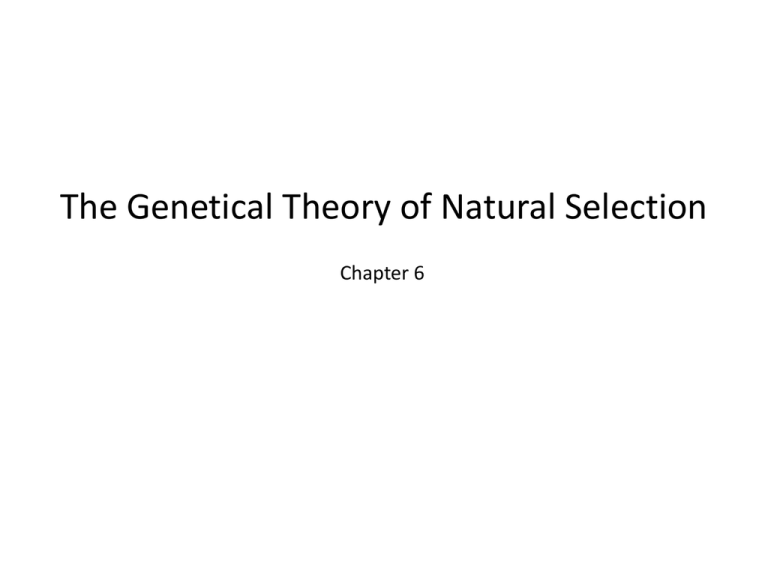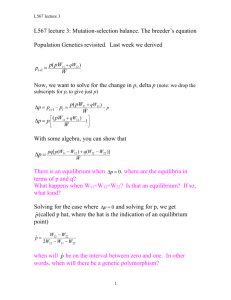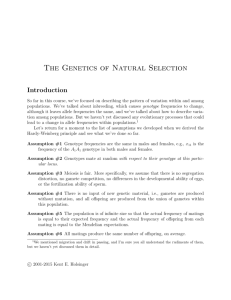
The Genetical Theory of Natural Selection
Chapter 6
Lecture Outline
1.
Fitness definition
2.
Modes and models of selection
General model of selection
• Directional selection
Ex: Warfarin
• Stabilizing selection
Ex: Sickle cell anemia and birth weight
• Diversifying selection
Ex: Seedcracker finch
• Frequency dependent selection
3.
4.
Natural selection outcomes
Strength of selection
Points to keep in mind about natural selection:
1.
Natural selection is not the same as evolution
Evolution
Origin of Genetic Variation
Changes in the Frequency of
Alleles and Genotypes
Mutation + Recombination
Genetic Drift + Natural Selection
2.
Natural selection can have no evolutionary effect unless phenotypes differ
in genotypes
3.
A feature cannot evolve by natural selection unless it makes a positive
contribution to the reproduction or survival of individuals that bear it
Natural selection proceeds independently at different loci
Fitness
Defining Fitness
Arnold Alois Schwarzenegger
Homo sapiens
Fitness
Defining Fitness
The fitness of a genotype is the average lifetime contribution of individuals of
that genotype to the population after one or more generations, measured at the
same stage in the life history
Absolute Fitness (Ri)
Per capita growth rate of each genotype i
Relative Fitness (Wi)
Is the absolute fitness of genotype i relative to the
absolute fitness of a reference genotype (R*)
Wi Ri / R
Fitness
Components of Fitness
ZYGOTIC SELECTION
Fecundity
Number of viable offspring per
female
Individual Viability
Probability of survival of the
genotype to reproductive age
Fertilization Success
Gamete’s ability to fertilize an
ovum
Gamete Viability
Probability of survival of the
gamete to fertilization
Segregation Distortion
Mating Success
Probability of being segregated
to the gamete
Number of mates obtained by an
individual (Sexual Selection)
GAMETE SELECTION
Models of Selection
Assumptions: large population, random mating, no mutation or migration,
viability selection only, discrete generations
1 Locus 2 Alleles
A1 p
A2 1-p=q
next generation
p’
we are interested in the change of frequency from one generation to the next
p’-p=Δp
if
Δp>0 frequency of A1 increase
Δp<0 frequency of A2 increase
Δp=0 frequencies do not change and we are at an equilibrium
Models of Selection
A1A1 A1A2 A2A2
Frequency
Birth
p2
2pq
q2
Fitness
w11
w12
w22
A1 in next generation
w11 p2 w12 12 2pq
A2 in next generation
w22q2 w12 12 2pq
Population mean fitness
w w11 p2 2w12 pqw22q2
Models of Selection
A1 in next generation
w11 p2 w12 pq
p
w
p p
w11 pw12q
w
Change in allele frequency
p p p p
w11 pw12q
p
w
wp pq w11 w12 p w22 w12 q
“Sticky ends” fixation of A1 (p=0) or A2 (q=0) results in no further change Δp=0
Fitness
Natural selection concerns selection on biological entities within populations
Modes of Selection
The relationship between phenotype and fitness can be described as one of
three modes of selection:
Directional Selection One extreme phenotype is the fittest
Stabilizing Selection An intermediate phenotype is the fittest
Diversifying Selection Two or more phenotypes are fitter than the
intermediates between them
Models of Selection
Directional Selection
Continuous trait
1 Locus 2 Alleles
w11 w12 ,w22
Intuition
Replacement of disadvantageous alleles by more advantageous alleles
A1 replaces A2
Models of Selection
Directional Selection
w11=1
Change in allele frequency
wp pq w11 w12 p w22 w12 q
w12=1- ½s
w22=1-s
Parametrization
wp spq
Equilibria p=1 (stable) and q=1
(unstable)
A1 always increases as suggested by intuition
Models of Selection
Directional Selection
The number of generations required for an advantageous allele to replace one
that is disadvantageous depends on:
• The initial allele frequencies
• The selection coefficient
• The degree of dominance
The mean fitness increases as natural selection proceeds
Models of Selection
Everybody Hates Rats
Models of Selection
Killing Ratatouille
Models of Selection
Ex of Directional Selection
Pied Piper of Hamelin
Warfarin is an anticoagulant that such that poisoned rats often bleed to death
from slight wounds
Models of Selection
Ex of Directional Selection
A mutation (Rw) confers resistance by
making the rats less sensitive to the poison
Rw/Rw
Rw/+
+/+
Models of Selection
Ex of Directional Selection
If a locus has experienced consistent
directional selection for some time, the
advantageous allele should be near fixation.
Thus the dynamics of directional selection
are best studied in recently altered
environments
Models of Selection
Stabilizing Selection
Continuous trait
1 Locus 2 Alleles
w12 w11 ,w22
Heterozygote advantage
Intuition
Both alleles are maintained in the population
A1 and A2 at equilibrium
Models of Selection
Stabilizing Selection
w12=1
Change in allele frequency
wp pq w11 w12 p w22 w12 q
w11=1-s
w22=1-s
Parametrization
s12ppq
wp pq sp sq
and p=½ (stable)
Equilibria p=1, q=1 (unstable)
A1 always increases when its frequency
is less than ½ but decreases when its
frequency is more than ½
Models of Selection
Ex of Stabilizing Selection
The best understood case of heterozygote advantage is the β-hemoglobin locus
in some African and Mediterranean human populations
S
A
Sickle-cell hemoglobin
Normal hemoglobin
Allele S results in the formation of S hemoglobin that forms elongated crystals,
which carry oxygen less effectively, causing the red blood cells to adopt a sickle
shape and to be broken down more rapidly.
Models of Selection
Ex of Stabilizing Selection
Sickle-cell Disease
Malaria
AA
Normal
Higher mortality
AS
Slight anemia
Lower mortality
SS
Severe anemia
(Sickle cell)
wAA=0.89
wAS=1
wSS=0.2
AA
AS
SS
Models of Selection
Ex of Stabilizing Selection
The heterozygote advantage arises from a balance of opposing selective factors:
anemia and malaria
AA
AS
SS
Models of Selection
Ex of Stabilizing Selection
In the absence of malaria, balancing selection gives way to directional selection
because the AA genotype has the highest fitness. African population q=0.13
African American q=0.05
Africa
AA
AS
America
SS
AA
AS
SS
Models of Selection
Ex of Stabilizing Selection
There is significant stabilizing selection on
neonate size. Small infants and large
infants die during child birth at a higher
rate than average-sized infants.
There is also a directional component to
selection. Notice that the optimal infant
size is one-half of a pound higher than the
average infant size in the population.
The pattern of low survival of large offspring has different causes than the
probability of low survival of small offspring. Small offspring may have had high
mortality because of inadequate nutrition during gestation, large offspring may
have died because of the large diameter of the cranium relative to the pelvic girdle
Models of Selection
Ex of Stabilizing Selection
6-9 Lbs
19 Lbs
2010
The previous data was collected back in 1958 before the advent of modern
techniques for the care of neonates. It would be interesting to know if the
widespread use of cesarean sections and other medical techniques have
altered the selection on neonate size
Models of Selection
Diversifying Selection
Continuous trait
1 Locus 2 Alleles
w11 ,w22 w12
Intuition
Both alleles are maintained in the population but in their homozygote
A1 and A2 at equilibrium
Models of Selection
Diversifying Selection
w11=1
Change in allele frequency
w22=1
wp pq w11 w12 p w22 w12 q
w12=1-s
Parametrization
wp pq sp sq
s 2p1 pq
p=½ (unstable)
Equilibria p=1, q=1 (stable) and
A1 always increases when its frequency
is more than ½ but decreases when its
frequency is less than ½
Models of Selection
Diversifying Selection
Seedcracker finch
Given the simple Mendelian inheritance for beak size, it is clear that disruptive
selection tends to maintain two distinct bill morphs by eliminating birds with
intermediate-sized bills
Models of Selection
Diversifying Selection
Seedcracker finch
Natural selection on beak size in seed cracking finches can be traced directly to
feeding performance of the two morphs on different sized seeds. Both modes
experience disruptive selection which refines the differences between morphs.
Mutation and Migration
Deleterious Alleles in Natural Populations
Although the most advantageous allele at a locus should be fixed by directional
selection, deleterious alleles often persist because they are repeatedly
reintroduced either by recurrent mutation or by gene flow from other
populations in which they are favored by a different environment
Mutation and Migration
Deleterious Alleles in Natural Populations
Consider an advantageous allele allele at a locus favored by natural selection
(directional selection) that tends to mutate to a deleterious form
Allele frequency after selection
w11=1
p p
w12=1- ½s
spq
w
w 1sq
Allele frequency after selection and mutation
w22=1-s
spq
p 1u p
w
Change in allele frequency
sq
p p 1 u
u
w
wp p 1u sq uw p sq u
Equilibria p=0 (unstable) and p=u/s (stable)
Mutation and Migration
Deleterious Alleles in Natural Populations
The frequency of the deleterious allele moves toward a stable equilibrium that is
a balance between the rate at which it is eliminated by selection and the rate at
which it is introduced by mutation
q
u
s
The same result is achieve when there is migration from between a small island
in which allele A1 is favored by directional selection and a large continent in
which allele A2 is fixed
Island
q
m
s
Continent
Models of Selection
Frequency Dependent Selection
In the models considered so far, the fitness of each genotype is assumed to be
constant within a given environment
Very often, however, the fitness of a genotype depends on the genotype
frequencies in the population. The population then undergoes frequency
dependent selection
Models of Selection
Frequency Dependent Selection
INVERSE FREQUENCY-DEPENDENT SELECTION:
The rarer a phenotype is in the population, the greater its fitness
Ex. Cichlid fish
Models of Selection
Frequency Dependent Selection
Cichlid fish
Perissodus microlepis
One of the strangest ways of making a living is found in the behavior of
Perissodus microlepis, a cichlid fish that specializes in eating scales. Perissodus
microlepis will swoop in on its prey from the blind side and eat some scales. The
scale-eater is a classic partial predator that feeds only on part of its prey, but
leaves the fish otherwise intact. What is strange about this behavior is that it
leads to a curious evolutionary cycle. At any point in time, there are two kinds of
scale-eaters. One is always slightly more common than the other.
Models of Selection
Frequency Dependent Selection
In 1982, left-jawed scale-eaters were the most common. The prey are more often
attacked on their right flank by a scale-eater with a jaw that curves to the left, so
the prey learns to look to the right when being vigilant to attack. While the prey
learn to look right, they leave their left flank exposed to the scale-eater with a jaw
that curves to the right. This gives the rarer right-jawed morphology an
advantage, and they do slightly better that year. The left-jawed morph does
slightly worse, because the prey is vigilant to attack from the right flank attack,
and the left-jawed morph declines in frequency.
Models of Selection
Frequency Dependent Selection
THE EVOLUTION OF THE SEX RATIO
Why is sex ratio about even (1:1) in many species of animals?
This is quite a puzzle:
• From a group-selectionist perspective we might expect that a female-biased
sex ratio would be advantageous because such a population could grow more
rapidly
• From a individual selection perspective why should a genotype producing an
even sex-ratio have an advantage over any other?
Models of Selection
Frequency Dependent Selection
THE EVOLUTION OF THE SEX RATIO
Because every individual has both a mother and a father, females and males must
contribute equally to the ancestry of subsequent generations and must therefore
have the same average fitness
Let the sex ratio be the proportion of males. Let S be the population sex ratio S. Let
s be an individual female sex ratio
Suppose that the population sex ratio is 0.25
Female
4 offspring
Male
12 offspring
Established genotype individual sex ratio 3:1
x3
12 grand offspring
x1
12 grand offspring
=24
Mutant genotype individual sex ratio 2:2
x2
8 grand offspring
x2
24 grand offspring
=32
Multiple Outcomes of Evolutionary Change
Initial genetic conditions often determines which of several paths of genetic
change a population will follow. The evolution of a population often depends on its
previous evolutionary history
POSITIVE FREQUENCY DEPENDENT SELECTION
The fitness of a genotype is greater the more
frequent it is in a population. As a result,
whichever allele is initially more frequent will be
fixed
Ex. Heliconius erato
Multiple Outcomes of Evolutionary Change
HETEROZYGOTE DISADVANTAGE
Monomorphism for either A1A1 or A2A2 is
therefore a stable equilibrium, and the initially
more frequent allele is fixed by selection. A
population is not necessarily driven by natural
selection to the most adaptive possible genetic
constitution
Multiple Outcomes of Evolutionary Change
ADAPTIVE LANDSCAPES
Metaphor introduced by Sewall Wright
INTERACTION OF SELECTION AND GENETIC DRIFT
In a finite population, allele frequencies are simultaneously affected by both
selection and chance
The effect of random genetic drift is negligible if selection on a locus is strong
relative to the population size
Multiple Outcomes of Evolutionary Change
Lecture Ideas
• Fitness is the average contribution of an individual of a genotype to the
population after one generation
• There are 3 modes of natural selection when fitness is constant: directional,
stabilizing and diversifying
• The first reduces variability the other two maintain variation
• There is also frequency dependent selection
• Frequency dependent selection maintain variability









